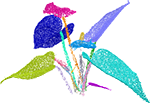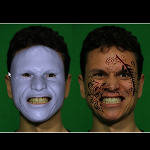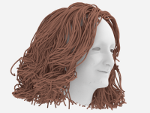
Analyzing Growing Plants from 4D Point Cloud Data
We introduce a framework to analyse time-lapse 3D scan of growing plants, particularly focusing on accurate localization and tracking topological events like budding and bifurcation. We evaluate our approach on multiple data sets and use the results to animate static virtual plants or directly attach them to physical simulators.
Yangyan Li, Shenzhen Institute of Advanced Technology
Xiaochen Fan, Shenzhen Institute of Advanced Technology
Niloy J. Mitra, University College London
Daniel A. Chamovitz, Tel Aviv University
Daniel Cohen-Or, Tel Aviv University
Baoquan Chen, Shenzhen Institute of Advanced Technology and Shandong University

Reconstructing Detailed Dynamic Face Geometry from Monocular Video
We present a method for capturing face geometry from monocular video. It works under uncontrolled lighting and successfully reconstructs expressive motion including high-frequency face detail. After simple manual initialization, the capturing process is fully automatic. We demonstrate performance capture results for long and complex sequences captured indoors and outdoors.
Pablo Garrido, Max Planck Institute for Informatics
Levi Valgaerts, Max Planck Institute for Informatics
Chenglei Wu, Max Planck Institute for Informatics
Christian Theobalt, Max Planck Institute for Informatics

Inverse Dynamic Hair Modeling with Frictional Contact
We present a method for converting a hair geometry into a physics-based hair model, such that the static hair pose, in the presence of gravity and frictional contact, accurately matches the input geometry. Our method was used to animate both artistic hairstyles and recent hair data reconstructed from capture.
Alexandre Derouet-Jourdan, INRIA and CNRS
Florence Bertails-Descoubes, INRIA and CNRS
Gilles Daviet, INRIA and CNRS
Joelle Thollot, INRIA and CNRS

On-Set Performance Capture of Multiple Actors With A Stereo Camera
We describe a new method which is able to track skeletal motion and detailed surface geometry of one ore more actors from footage recorded with a stereo rig that is allowed to move. It succeeds in general sets with uncontrolled background and uncontrolled illumination.
Chenglei Wu, Max Planck Institut Informatik
Carsten Stoll, Max Planck Institut Informatik
Levi Valgaerts, Max Planck Institut Informatik
Christian Theobalt, Max Planck Institut Informatik






